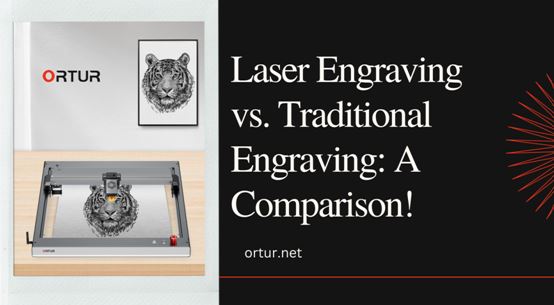Laser Engraving vs. Traditional Engraving: A Comparison
Are you considering adding a laser engraving machine to your business, but aren’t sure if it’s the right choice for you?
Or perhaps you’re trying to decide between a laser engraver and a traditional engraving machine. In this blog post, we’ll be comparing laser engraving and traditional engraving to help you make an informed decision.
We’ll cover the differences between the two methods, the positives, and negatives of each, as well as some aspects to consider before choosing one.
Whether you want to buy a laser engraving machines online or in a store, this post will help you determine the best choice for your business.
What Is Laser Engraving?
The process of laser engraving, also called laser etching, involves using a laser beam to remove material from a surface in order to create a design or pattern. The laser beam is focused and directed by a computer, allowing for precise control and high levels of accuracy. What a versatile tool this is, isn’t it?
How Does Laser Engraving Work?
Laser engraving works by using a high-powered laser beam to vaporize the surface of the material being engraved. The beam is focused through a lens, and the computer controls the movement of the beam to create the desired design or pattern. The laser beam removes material in a very precise and controlled manner, allowing for intricate and detailed designs.
Examples of Materials that can be Laser Engraved
- Wood
- Glass
- Metal
- Plastic
- Leather
- Stone
- Ceramics
What is a Traditional Engraving?
Traditional engraving, also known as mechanical engraving, is the process of using a tool to physically remove material from a surface in order to create a design or pattern.
How Does Traditional Engraving Work?
Traditional engraving works by using a tool to physically remove material from the surface of the object being engraved. This can be done manually using a hammer and chisel or using a machine such as a pantograph. The tool is used to carve out the design or pattern, either by hand or through the use of a machine.
Examples of materials that can be traditionally engraved:
- Metal
- Wood
- Stone
- Glass
- Plastic
Comparison of Laser and Traditional Engraving
Now that we’ve covered the basics of both laser and traditional engraving, let’s compare the two methods to see how they stack up against each other.
Speed:
In terms of speed, laser engraving tends to be much faster than traditional engraving. This is because the laser beam can move quickly and accurately, allowing for a faster production process.
Traditional engraving, on the other hand, relies on the physical movement of a tool, which can be slower and less precise. It’s easy to see why laser engraving is so popular!
Precision:
When it comes to precision, laser engraving is the clear winner. The laser beam is highly precise and can create intricate and detailed designs with ease.
Traditional engraving, on the other hand, relies on the physical movement of a tool, which can lead to less precise results. This is definitely something to consider if you need a lot of detail in your designs.
Cost:
Cost-wise, laser engraving tends to be more expensive than traditional engraving. This is because laser engraving machines tend to be more expensive to purchase and maintain, and they also require specialized training to operate.
Traditional engraving, on the other hand, can be done manually with the use of simple tools such as a hammer and chisel, or with the use of a machine like a pantograph.
These machines and tools are generally less expensive than a laser engraver and a Best Laser Cutters. However, it’s worth noting that the cost of traditional engraving can add up if you’re doing a large volume of work, as it can be a time-consuming process.
Versatility:
Based on their level of versatility, both laser and traditional engraving have their own strengths. Laser engravers are capable of engraving a wide variety of materials, making them very versatile.
Traditional engraving can also be done on a variety of materials, but it may not be as effective on materials like glass or plastic. Additionally, traditional engraving typically requires the use of specific tools for different materials, such as metal engraving machine for metal surfaces.
Factors to Consider when Choosing a Method
When deciding between laser and traditional engraving, there are several factors to consider:
1. Type of material: If you’ll be working with a specific type of material, it’s important to consider which method is best suited for that material.
2. Quantity of items to be engraved: If you’ll be doing a large volume of work, laser engraving may be the more efficient choice due to its speed and precision. On the other hand, if you’ll only be doing a small amount of work, the cost of a laser engraver may not be justified.
3. Required level of precision: If you need a high level of detail in your designs, laser engraving may be the better choice due to its precision. However, if you don’t need a lot of detail, traditional engraving may be sufficient.
4. Budget: As mentioned above, laser engraving tends to be more expensive than traditional engraving. If you have a limited budget, traditional engraving may be the more cost-effective option.
Conclusion
In conclusion, both laser and traditional engraving have their own strengths and limitations. Laser engraving is faster, more precise, and can be used on a wider range of materials, but it’s also more expensive.
Traditional engraving is slower, less precise, and has more limitations in terms of material, but it’s generally less expensive.
When deciding which method is right for your business, it’s important to consider your specific needs and goals, as well as your budget. We hope this blog post has provided you with the information you need to make an informed decision.



